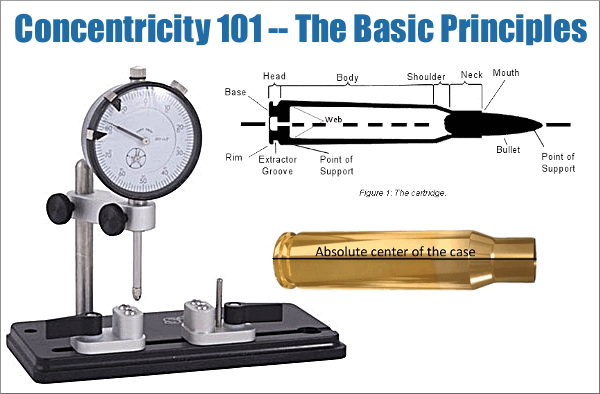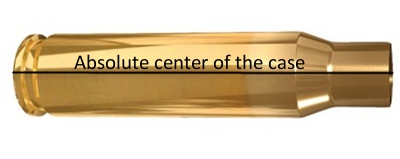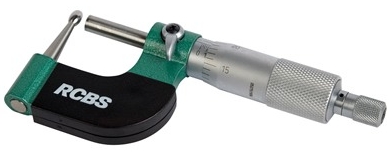Bullet Concentricity Basics — What You Need to Know

 Sinclair International has released an interesting article about Case Concentricity* and bullet “run-out”. This instructional article by Bob Kohl explains the reasons brass can exhibit poor concentricity, and why high bullet run-out can be detrimental to accuracy.
Sinclair International has released an interesting article about Case Concentricity* and bullet “run-out”. This instructional article by Bob Kohl explains the reasons brass can exhibit poor concentricity, and why high bullet run-out can be detrimental to accuracy.
Concentricity, Bullet Alignment, and Accuracy by Bob Kohl
The purpose of loading your own ammo is to minimize all the variables that can affect accuracy and can be controlled with proper and conscientious handloading. Concentricity and bullet run-out are important when you’re loading for accuracy. Ideally, it’s important to strive to make each round the same as the one before it and the one after it. It’s a simple issue of uniformity.The reason shooters work with tools and gauges to measure and control concentricity is simple: to make sure the bullet starts down the bore consistently in line with the bore. If the case isn’t properly concentric and the bullet isn’t properly aligned down the center of the bore, the bullet will enter the rifling inconsistently. While the bore might force the bullet to align itself with the bore (but normally it doesn’t), the bullet may be damaged or overstressed in the process – if it even it corrects itself in transit. These are issues we strive to remedy by handloading, to maintain the best standard possible for accurate ammunition.
The term “concentricity” is derived from “concentric circle”. In simple terms it’s the issue of having the outside of the cartridge in a concentric circle around the center. That goes from case head and center of the flash hole, to the tip of the bullet.
Factors Affecting Concentricity
The point of using this term is to identify a series of issues that affect accurate ammunition. Ideally this would work best with a straight-walled case; but since most rifle cartridge cases are tapered, it equates to the smallest cross section that can be measured point by point to verify the concentric circle around the center. For the examples below, I’m working with .308 Winchester ammo.

Figure 1: The cartridge.

Figure 2: Centerline axis of the case, extending from flash hole to case mouth.
The case walls have to be in perfect alignment with the center, or axis, of that case, even if it’s measured at a thousandth of an inch per segment (in a tapered case).

Figure 3: Case body in alignment with its axis, or centerline, even in a tapered case.
The case neck must also be in alignment with its axis. By not doing so you can have erratic bullet entry into the bore. The case neck wall itself should be as uniform as possible in alignment and in thickness (see the M80 7.62x51mm NATO cartridge in Figure 5) and brass can change its alignment and shape. It’s why we expand the case neck or while some folks ream the inside of the neck and then turn the outside for consistent thickness, which affects the tension on the bullet when seated.

Figure 4: Neck in alignment with center of the case axis.

Figure 5: Variations in case neck wall thickness, especially on some military brass, can cause an offset of the bullet in its alignment. This is an M80 ball round. Note the distinct difference of the neck walls.
Having a ball micrometer on hand helps, especially with military brass like 7.62x51mm in a semi-auto rifle, where there are limits as to how thin you want the neck walls to be. In the case of 7.62 ball brass you want to keep the wall to .0145″.

Figure 6: A ball micrometer like this RCBS tool (#100-010-268) can measure case neck thickness.
Turning the outside of the neck wall is important with .308 military cases regardless of whether you expand or ream the neck walls. There are several outside neck turning tools from Forster, Hornady, Sinclair, and others. I’ve been using classic Forster case trimming (#100-203-301) and neck turning (#749-012-890) tools for 40 years.
Bullet Run-Out
The cartridge, after being loaded, still needs to be in alignment with the center of the case axis. Figure 7 shows a bad example of this, a round of M80 ball. A tilted bullet is measured for what’s known as bullet “run-out”.

Figure 7: An M80 round with the bullet tilted and not aligned with the axis. This will be a flyer!
Run-out can be affected by several things: (1) improperly indexing your case while sizing, which includes not using the proper shell holder, especially while using a normal expander ball on the sizing die (it also can stretch the brass). (2) The head of a turret press can flex; and (3) improper or sloppy bullet seating. This is also relevant when it comes to using a progressive press when trying to load accuracy ammo.
Mid Tompkins came up with a simple solution for better bullet seating years ago. Seat your bullet half way into the case, back off the seater die and rotate the case 180 degrees before you finish seating the bullet. It cuts down on run-out problems, especially with military brass. You also want to gently ream the inside of the neck mouth to keep from having any brass mar the surface of the bullet jacket and make proper seating easier. A tilted bullet often means a flyer.

Figure 8: Proper alignment from the center of the case head to the tip of the bullet.
» CLICK HERE to READ FULL ARTICLE With More Photos and Tips
(NOTE: This links to a Web Archive version of older Sinclair Int’l article.)
*Actually some folks would say that if we are talking about things being off-center or out-of-round, we are actually talking about “eccentricity”. But the tools we use are called “Concentricity Gauges” and Concentricity is the term most commonly used when discussing this subject.
Story Tip from EdLongrange. We welcome reader submissions.Similar Posts:
- Bullet Concentricity and Alignment — What You Need to Know
- Bullet Concentricity and Alignment — Key Things to Understand
- Bullet Concentricity and Related Issues
- Concentricity, Bullet Alignment, and Accuracy — Basic Principles
- H&H Concentricity Gauge and Bullet Straightener
Tags: bullet, Case Sizing, Concentricity, Concentricity Gauge, Eccentricity, Reloading, Run-Out, Sinclair Int'l, TIR


















The most important consideration for producing concentric ammo, after quality brass, are the dies. They need to match the chamber of the rifle that they are used to load for, so that the minimum amount of sizing is done that is consistent with the type of rifle and how it will be used. Obviously this will be different for target bolt actions, hunting rifles, and semiautomatics. One piece sizing dies that over size the neck causing excessive pull as the expander is pulled through are to be avoided at all cost. It is not the expander that is the problem, but rather the ID of the neck part of the die. If your sizing die does not produce relatively straight sized brass, it will have to be replaced, or modified. There is no substitute for a die that produces straight brass. Nothing else can compensate for the accuracy lost by its use.
Seating a bullet into a case is much like seating a dowel pin for location. The dowel pin must enter its hole at least 1 1/2 times its diameter to be stable and effective. No special tooling required, other than a ball peen. If you are not, you can easily undo any accuracy you have obtained by poor handling of the rounds afterwards.
Tool and Die 101.
James, making straight ammo is nothing like that.
can non-straight press makes non-straight seated bullet ammo?
i think that brass slide on shellholder (if not too tight put in) in direction that seating die controls, so the direction of the brass and bullet on the top of it is controled with the seating die tightness, and not that non straight press can push the brass non straight into the seating die…?
I’ve taken Mr. Tompkins tip a step further , in that I rotate the round in six to eight incremental steps as I seat my bullets . Apparently it works with my dies , as I seldom have a round more than .0015 out . Most are between .0005 / .0010 . You don’t get in a hurry to shoot , so why be in a hurry to load ?
The article shows the Hornady and Sinclair run out checkers. I think the same loaded cartridge measured on both devices will give your two different readings. The reason is they way the cartridge is held, with the Sinclair device showing more run out than the Hornady.
With the Sinclair device the further you move the indicator away from the front support the more run out you will show.
On the Hornady unit the indicator is between the supports.
Gene I have tried this but it has not yielded better result yet. That said my concentricity is usually better then .001 on my BRX and the dies I have for it. Now my Redding dies are bad. Usually runout is in the .002-4 range. Turning them and completing the seating has not helped. There must be something else a foot.